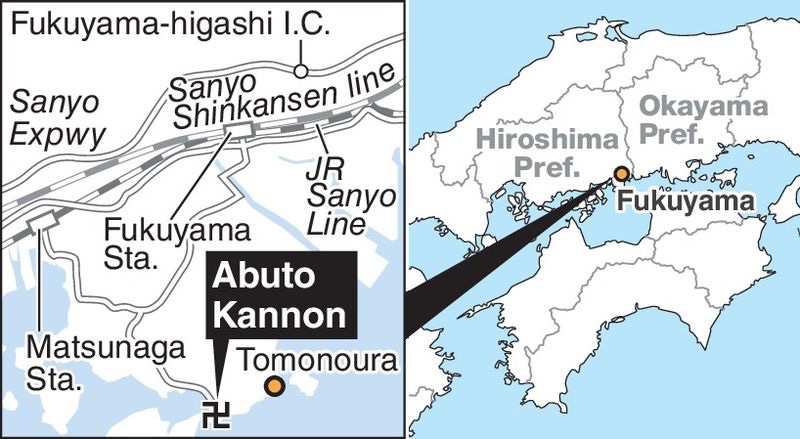
Bandai Temple stands on a cliff on Cape Abuto in Fukuyama, Hiroshima Prefecture.
13:28 JST, December 25, 2021
FUKUYAMA, Hiroshima — A vermilion-painted temple stands on the cliffs of a cape, its rocky surface eroded by the waves. Boasting one of the best views in the Seto Inland Sea, the Abuto Kannon Bandai Temple stands at the southernmost tip of the Numakuma Peninsula, about 4 kilometers southwest of the famous scenic Tomonoura in Fukuyama, Hiroshima Prefecture. The view of the temple from the sea is of course wonderful, but the temple, located more than ten meters above sea level, offers a breathtaking view of the sea.
The temple is dedicated to Kannon — a Buddhist deity of mercy — and is said to have been built by Mori Terumoto, who ruled the Chugoku region in the late 16th century during Japan’s warring states period.
A stone statue of the eleven-faced Kannon is enshrined in the hall, with no record of it ever having been opened. It is said to be about 60 centimeters tall.
The statue is also said to have originated from a retired emperor in around 986, according to a local historical document. When Emperor Kazan, who had then taken up a life of Buddhism, was on a boat trip to Kyushu, a gust of wind capsized the ship and threw him and those accompanying him overboard. They managed to survive by swimming to Cape Abuto. The cloistered emperor then enshrined a Kannon statue there to pray for safety in navigation.
Later, the statue was lost at the sea amid battles between two prominent warrior families — Minamoto and Taira — on the coast of the Seto Inland Sea in the late 12th century. A few hundred years later, it was caught in a fisherman’s net and was enshrined on the cape. Terumoto, the ruler at the time, heard the stories about the Kannon statue and built the temple dedicated to it.
Oppai Kannon
The temple is known as the “Oppai Kannon” on the internet. “Oppai” means “breast” in Japanese, and the temple is known as a place of prayer for those who wish to have a child, have a safe delivery or raise a child well.
There are many strange-looking ema votive tablets hanging on the walls inside the temple. The tablets feature breast-shaped objects with wishes written on them, such as a wish for an abundance of breast milk.

Ema featuring breast-shaped objects are seen at the temple with people’s wishes written on them, such as “May we have a healthy baby.”
“The Kannon deity is a symbol of a parent’s mercy for their child, and the breast is the symbol of a mother,” said Giten Mori, the 69-year-old priest of the temple. “I hope people will understand the original meaning behind the breasts featured on the ema.”
He explained the ema began as a gesture of gratitude from a woman who was able to have a child and raise it well thanks to her prayers to the deity. The woman dedicated an ema with breast-shaped bags filled with rice to the temple. In such days of poverty, another woman with a baby would take the rice home from the temple and eat it to help her body produce milk, according to the priest.
“The breasts represent the paying-it-forward kindness of the old days, when people wanted to help someone after having been helped themselves,” the priest said.
I wondered why the temple became a temple for mothers despite the many temples in Japan that worship the Kannon deity.
“Our temple looks to be floating in the sea, the origin of life,” Mori said.
Despite the harsh environment of the cliffs, I felt healed by the ocean. Is this the reason for how I felt? I couldn’t help but think about the harmony of nature and religion.
How to get there

From the south exit of JR Fukuyama Station, take the Tomotetsu Bus for about 50 minutes, get off at Abuto Kannon Iriguchi, and walk for about 15 minutes. From the south exit of JR Matsunaga Station, take the bus for about 35 minutes, get off at Abuto Kannon, and walk for about 5 minutes. By car, it takes about 40 minutes from the Sanyo Expressway Fukuyama-higashi interchange. The temple is open from 8 a.m. to 5 p.m. The entrance fee is ¥100 for junior high school students and older, and ¥50 for elementary school students.
Related Tags
"Features" POPULAR ARTICLE
-

Sanrio to Open Museum in Yamanashi Pref. Dedicated to Founder, Exhibits Include Hello Kitty, Other Characters
-

Autumn Foliage Surrounds Visitors to Tokyo’s Showa Kinen Park
-

My Daughter No Longer Speaks to Me, But I Want to See Her and My Grandchild
-

Kumamoto: Public Bath Refurbished as Library Where You Can Chat, Take Photos
-

Frozen Vegetables: Demand Rises for Convenient, Tasty Domestic Produce
JN ACCESS RANKING
-

Keidanren Chairman Yoshinobu Tsutsui Visits Kashiwazaki-Kariwa Nuclear Power Plant; Inspects New Emergency Safety System
-

Imports of Rare Earths from China Facing Delays, May Be Caused by Deterioration of Japan-China Relations
-

Tokyo Economic Security Forum to Hold Inaugural Meeting Amid Tense Global Environment
-

University of Tokyo Professor Discusses Japanese Economic Security in Interview Ahead of Forum
-

Japan Pulls out of Vietnam Nuclear Project, Complicating Hanoi’s Power Plans


























